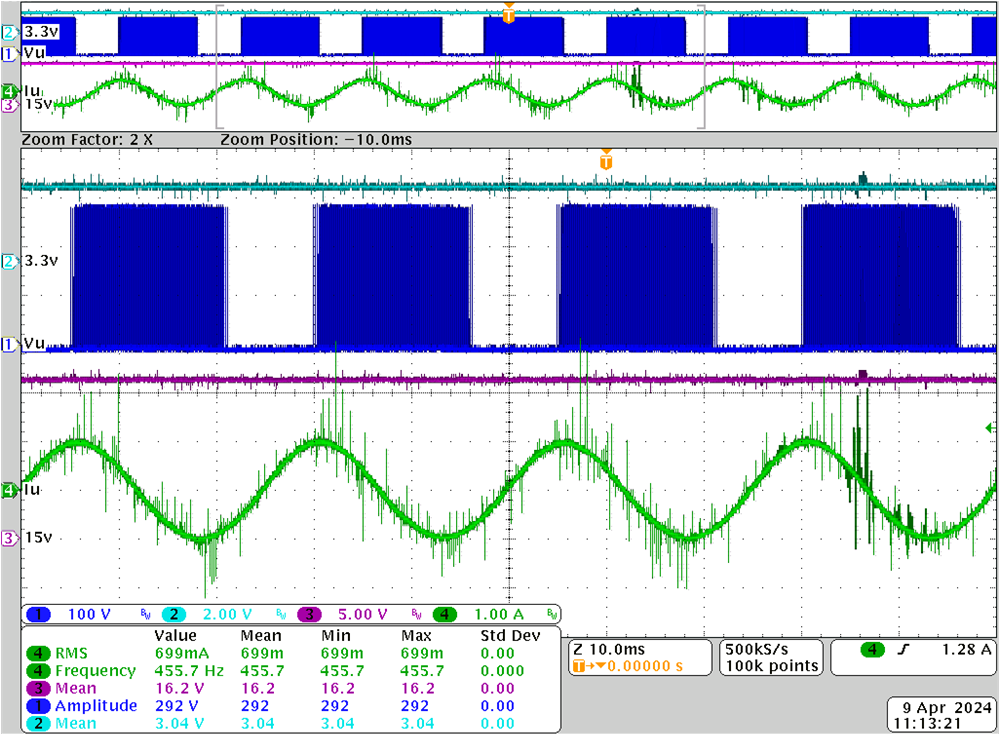TIDUF77 June 2024 MSPM0G1507
- 1
- Description
- Resources
- Features
- Applications
- 6
- 1System Description
-
2System Overview
- 2.1 Block Diagram
- 2.2 Design Considerations
- 2.3 Highlighted Products
- 2.4
System Design Theory
- 2.4.1
Hardware Design
- 2.4.1.1 Modular Design
- 2.4.1.2 Auxiliary Flyback Power Supply
- 2.4.1.3 DC Link Voltage Sensing
- 2.4.1.4 Inrush Current Protection
- 2.4.1.5 Motor Phase Voltage Sensing
- 2.4.1.6 Motor Phase Current Sensing
- 2.4.1.7 Over Current Protection of DRV7308
- 2.4.1.8 Internal Overcurrent Protection for TMS320F2800F137
- 2.4.2 Three-Phase PMSM Drive
- 2.4.1
Hardware Design
-
3Hardware, Software, Testing Requirements, and Test Results
- 3.1 Getting Started Hardware
- 3.2 Getting Started GUI
- 3.3
Getting Started C2000 Firmware
- 3.3.1 Download and Install Software Required for Board Test
- 3.3.2 Opening Project Inside CCS
- 3.3.3 Project Structure
- 3.3.4 Test Procedure
- 3.4
Test Results
- 3.4.1 Fast and clean Rising/Falling Edge
- 3.4.2 Inrush Current Protection
- 3.4.3 Thermal performance under 300VDC
- 3.4.4 Thermal performance under 220VAC
- 3.4.5 Overcurrent Protection by Internal CMPSS
- 3.4.6 IPM Efficiency with External Bias Supply under 300VDC
- 3.4.7 Board Efficiency with Onboard Bias Supply under 300VDC
- 3.4.8 Board Efficiency with External Bias Supply under 220VAC
- 3.4.9 Board Efficiency with Onboard Bias Supply under 220VAC
- 3.4.10 iTHD Test of Motor Phase Current
- 3.4.11 Standby Power Test
- 3.5 Migrate Firmware to a New Hardware Board
- 3.6 Getting Started MSPM0 Firmware
- 4Design and Documentation Support
- 5About the Author
3.3.4.2.4 Run the Code
To run the code, complete the following steps:
- Set the AC power source output to 0V, turn on the AC power source, slowly increase the output voltage from 0V to 220-VAC.
- Run the project by clicking on the
button, or click Run → Resume in the Debug tab. The motor fault flags motorVars_M1.faultMtrUse.all need to be equal to "0" , if not, the user must check the current and voltage sensing circuit as described in Section 3.3.4.1.
- To verify the current and voltage-sensing circuit of the inverter for the motor, set the variable motorVars_M1.flagEnableRunAndIdentify to "1" in the Expressions window as shown in Figure 3-30. The motor_1 needs to run with v/f open loop, tune the v/f profile parameters in user_mtr1.h as below according to the specification of the motor if the motor does not spin smoothly.
#define USER_MOTOR1_FREQ_LOW_Hz (10.0f) // Hz #define USER_MOTOR1_FREQ_HIGH_Hz (275.0f) // Hz #define USER_MOTOR1_VOLT_MIN_V (10.0f) // Volt #define USER_MOTOR1_VOLT_MAX_V (200.0f) // Volt - The motor now spins with a setting speed in the variable motorVars_M1.speedRef_Hz, check the value of motorVars_M1.speed_Hz in the Expressions window. The value needs to be very close, as shown in Figure 3-30.
- Connect the oscilloscope voltage and current probes to watch the motor phase voltage and current as shown in Figure 3-31.
- Verify the overcurrent fault protection by decreasing the value of the variable motorVars_M1.overCurrent_A, the overcurrent protection is implemented by the CMPSS modules. The overcurrent fault is triggered if the motorVars_M1.overCurrent_A is set to a value less than the actual current, the PWM output is disabled, the motorVars_M1.flagEnableRunAndIdentify is cleared to "0", and the motorVars_M1.faultMtrUse.all is set to "0x10".
- The controller can now be halted, and the debug connection terminated. Fully halting the controller by first clicking the Halt button on the toolbar
or by clicking Target → Halt. Finally, reset the controller by clicking on
or clicking Run → Reset.
- Close the CCS debug session by clicking on Terminate Debug Session
or clicking Run → Terminate.
 Figure 3-30 Build Level 2: Expressions Window at Run Time
Figure 3-30 Build Level 2: Expressions Window at Run Time Figure 3-31 Build Level 2: Motor Phase Voltage and Current
Figure 3-31 Build Level 2: Motor Phase Voltage and Current